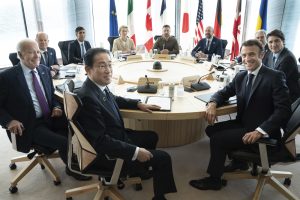The G-7 Hiroshima Summit was a historic success. A key element of this success was the commitment of world leaders to the principle that nuclear weapons should never be used again. This was the first time that representatives from every continent had come together to recognize the enormous sufferings of a city that was the first in human history to feel the devastating effects of an atomic bomb. That the summit started and ended at the Hiroshima Peace Memorial symbolized this desire for peace.
The summit made history in other ways too. It redefined Japan’s place as a bridge between the G-7 countries and the rest of the world. For a very long time, as the only member not from Europe or North America, Japan was the odd one out at the G-7. Although it joined the group at a very early stage, it was admitted only because of its economic clout and did not share the cultural background of other members. Japanese prime ministers were very often not speakers of English, and struggled to become part of the informal old boys club atmosphere. My generation remembers vividly the uneasy and uncertain smiles frequently on the faces of Japanese leaders as they stood at the edge of the G-7 “family photos.” No longer. At the Hiroshima Summit, Prime Minister Kishida Fumio confidently led the group while his wife elegantly did the same for the partner’s program. It was a summit of a kind we have not seen before, celebrating diversity in gender, race, and geography.
The proportion of the world represented by the G-7 has shrunk considerably since the group’s inception in the 1970s. Starting in the 17th century, Europe rose to dominate the globe through its process of modernization and globalization. The international society that we live in today, a society of sovereign and equal states, is a European invention. But now is a time to rethink this society. We are in the process of transitioning to a more globalized world, and the rules and the institutions of international society need to be updated to reflect the diversity of the world we inhabit.
That does not mean totally re-inventing the world. It definitely need not mean accepting an imperialistic redefinition by a new global hegemon, whatever form that may take. Global institutions need to be changed, reformed, adapted and reinterpreted, but in a stable and peaceful manner. The G-7 can still contribute to the world in leading the rule-making by preserving what is valuable, while also listening humbly to new ideas and voices from other parts of the world. The group can still play an important coordinating role in this very difficult transition era. The Indo-Pacific has been a center of world growth for several centuries, and now deserves to take center stage. Japan can play a crucial role in this difficult period of transition, and the G-7 Hiroshima Summit offers a glimpse of that possibility.
The presence of leaders from South Korea Korea and Australia underscored Japan’s position as the linchpin of an Asian network of like-minded partners with shared values. Australia and Japan have deepened their strategic ties in recent years. The Japan-South Korea relationship, meanwhile, was the final missing piece in this network of partners. The image of the two countries’ leaders with their partners laying a wreath in front of the memorial remembering Korean victims of the atomic bomb in Hiroshima was a historic moment in the bilateral relationship. If this relationship could be solidified and institutionalized, it may one day come to be regarded as something like the Franco-German Axis of postwar European integration, which formed the basis for the peaceful development of Europe. Perhaps we should think about an “Elysée Treaty” for Japan and South Korea, learning from the 1963 Franco-German treaty of friendship that still today offers a solid basis for the relationship between those two erstwhile enemies.
Efforts to engage global partners had already begun at previous G-7 summits, but gathered momentum at the Hiroshima Summit. Most of the challenges that the world faces today –climate change, energy transition, food security, or global health problems – cannot be solved by the G-7 alone. The group needs to work with partners around the world, and the presence and weight of other leaders at the Hiroshima Summit showed that the G-7 clearly recognizes this. Eight leaders from non-G-7 member states were present at the summit, representing each of the world’s continents and regional institutions. The presence of Indonesia, representing ASEAN, and the Cook Islands, representing the Pacific Islands Forum, showed a vision of the world that did not previously exist within the G-7, an Indo-Pacific vision, one that is more open and diverse, seeking to offer an equal place for partners large and small.
With its aging, declining population, Japan is conscious that it is not in a position to dictate this emerging century. Without connecting to the vibrant and growing Indo-Pacific, its future is grim. Indeed, all members of the G-7 need to become aware that we are entering a new era, one that requires countries to work together to maintain world peace and stable growth. This will in turn demand sincere respect for each other’s values and culture, as well as a willingness to communicate and learn. The hope for Japan is that the Hiroshima Summit will be remembered as the moment that this process truly got underway.

































